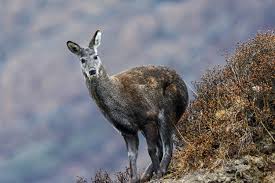- Courses
- GS Full Course 1 Year
- GS Full Course 2 Year
- GS Full Course 3 Year
- GS Full Course Till Selection
- Online Program
- GS Recorded Course
- NCERT (Recorded 500+ Hours)
- Polity Recorded Course
- Geography Recorded Course
- Economy Recorded Course
- AMAC Recorded Course
- Modern India, Post Independence & World History
- Environment Recoded Course
- Governance Recoded Course
- Science & Tech. Recoded Course
- International Relations and Internal Security Recorded Course
- Disaster Management Module Course
- Ethics Recoded Course
- Essay Recoded Course
- Current Affairs Recoded Course
- CSAT
- 5 LAYERED ARJUNA Mentorship
- Public Administration Optional
- ABOUT US
- OUR TOPPERS
- TEST SERIES
- FREE STUDY MATERIAL
- VIDEOS
- CONTACT US
Musk Deer Conservation: CZA Highlights Inaction in Indian Zoos
Musk Deer Conservation: CZA Highlights Inaction in Indian Zoos
26-04-2025

- A recent report by the Central Zoo Authority (CZA) confirms that no breeding programme has been initiated in Indian zoos for the conservation of musk deer.
- This raises concerns for a species already under significant poaching pressure and facing habitat threats.
What Are Musk Deer?
- Musk deer are small, solitary hoofed mammals (ungulates), active mainly during night or twilight hours.
- They belong to the family Moschidae and are known for their shy and elusive nature.
- The group consists of 7 recognized species, such as the Kashmir musk deer, Himalayan musk deer, and Anhui musk deer.
- These species are found across 13 Asian countries, including India, Nepal, Bhutan, Pakistan, China, Myanmar, and Russia (Siberia).
Why Are They Hunted?
- Adult male musk deer possess a musk gland, which secretes a substance used to attract mates during the breeding season.
- This musk secretion is highly valued in the perfume industry, making the species vulnerable to illegal hunting and poaching.
Where Are Musk Deer Found in India?
- Key habitats in India include the Askot Wildlife Sanctuary (Uttarakhand) and Gangotri National Park.
- These areas provide the cold, forested environments needed for the species' survival.
Conservation Status of Musk Deer
- As per the IUCN Red List, most musk deer species are classified as Endangered, except the Siberian musk deer, which is listed as Vulnerable.
- Under CITES (Convention on International Trade in Endangered Species):
- Populations from Afghanistan, Bhutan, India, Myanmar, Nepal, and Pakistan are listed in Appendix I (highest protection).
- All other populations are included in Appendix II.
- In India, the species is protected under Schedule I of the Wildlife (Protection) Act, 1972, offering the highest level of legal safeguard.
|
Also Read |
|
| NCERT Books For UPSC | |
| UPSC Monthly Magazine | Best IAS Coaching in Delhi |


![img-PSYCHOLOGICAL WARFARE [PSYWAR]](https://i.filecdn.in/755esias/PSYCHOLOGICALWARFAREPSYWAR-1747206772505.jpg)

